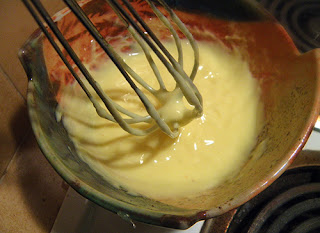 |
| Bright Winter Brunch or Supper |
Recipe by Robin and the Boston Cooking School Cookbook
When I reported in our January
menus post that January is National Egg Month, I should have “examined” my source
more carefully. According to the American
Egg Board, May is Egg Month. Nevertheless, I spent the month of January
coming up with a recipe to honor the humble egg. The carrot soufflé that
sounded so good was an utter failure. Then I remembered the first fancy dish I
ever made: Eggs Benedict. I’ve never been a ham fan, so I substitute spinach
(officially called Eggs Florentine). I’ve included a ham option in my recipe.
Key to a great Benedict (or Florentine) is perfect old school Hollandaise sauce.
You’d never know that at certain restaurants, where they serve thin gray salty
sauce, dyed-orange white sauce, or even melted Swiss cheese on Benedicts.
That’s just wrong.
 |
| Hollandaise Sauce: Key to Success |
 |
| Perfect Hollandaise |
 |
| Adding Poached Egg to Base Layers |
serves 2
2 cups lightly packed baby spinach
2 slices ham or Canadian bacon (optional)
Hollandaise sauce (recipe below)
1 tbsp. vinegar
4 large eggs
2 English muffins
Spinach and/or ham:
Remove spinach stems. Steam spinach for about 5 minutes,
until wilted. Set aside to keep warm in steamer.
Pan-fry the ham for a few minutes until brown, and set pan
aside, covering and keeping warm.
Hollandaise sauce:
Make Hollandaise according to directions below. Keep warm
over hot water (see details below) while cooking eggs and English muffins.
Prepare plates:
Put two heat-proof plates into the oven and set oven
temperature to warm (about 125 degrees).
Toasted muffins:
Toast English muffins in toaster oven. When done, slide two
halves onto each plate in the oven.
Poached eggs:
Finessing the Timing:
While muffins are toasting, poach the eggs. It’s best if you can remove the
poached eggs from the pan and put them directly onto English muffins. This is
easiest to coordinate if a helper tops the muffins with spinach and/or ham
while you’re poaching the eggs. If need be though, you can remove the eggs from
the water into individual ramekins while you assemble the dish.
To poach: Add about
2” (or a bit less) of water to a wide, shallow pan. Stir in vinegar. Bring to a
slow and gentle simmer. One at a time, break eggs into small bowl, then make a
“whirlpool” in the simmering water with a teaspoon. Slip egg into whirlpool.
Repeat until all 4 eggs are in the pot. Simmer for about 4 minutes, until
whites are set and yolks look defined, but are still slightly yielding. Remove
eggs one at a time with a slotted spoon, blotting excess water from bottom of
spoon with a paper towel.
Assemble Florentines/Benedicts:
Remove warmed plates with English muffins from oven. Top
muffins with spinach and/or ham slice. Carefully layer a poached egg onto each
muffin. Top with Hollandaise sauce, and serve with extra sauce.
Hollandaise Sauce
½ cup (1 stick) butter
2 egg yolks
¼ tsp. salt
pinch of cayenne pepper
1 tbsp. lemon juice
Use a double boiler or heavy ceramic bowl in a pot of hot
water to cook the Hollandaise. If using a bowl, keep the level of water low,
and the temperature at simmering or below. If using a double boiler, keep the
water level in lower pot substantially below the upper pot.
Heat water that Hollandaise will cook over to just below
simmering, but don’t put bowl or second layer of double boiler on yet.
Divide butter into 3 pieces and place in microwave for about
10 seconds, until softened. Mix together salt, cayenne, and lemon juice. Put
egg yolks into bowl or top of double boiler. Whisk in lemon mixture thoroughly.
Keep the pot of water just below simmering by placing over
low heat.
Add one piece of butter to yolk mixture and place mixture
over hot water. Whisk constantly until butter is melted and incorporated.
Immediately whisk in second piece of butter. When melted, whisk in last piece
of butter, and continue whisking until moderately thick, about 5 – 6 minutes.
Don’t overcook.
If mixture overcooks (curdles), you can save it by whisking
in boiling water a drop or two at a time.
 |
| Feast for the Eyes, and the Tastebuds! |

No comments:
Post a Comment